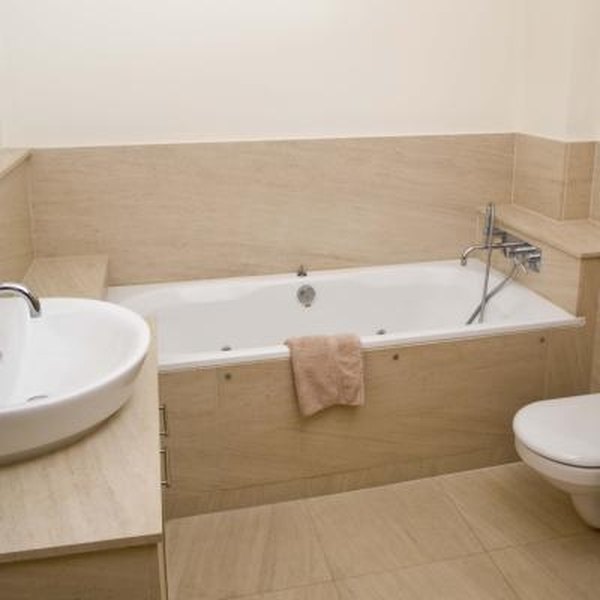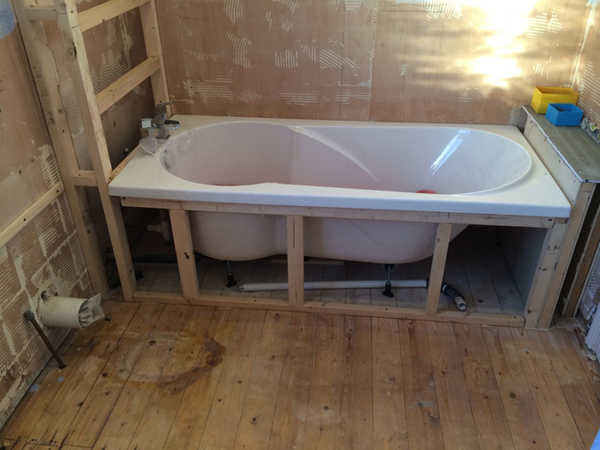Getting Familiar with Plumbing: Before Installing a Bathtub
Getting Familiar with Plumbing: Before Installing a Bathtub
Blog Article
The author is making a few great observations related to How to Install a Bathtub Yourself overall in this great article in the next paragraphs.

Mounting a tub isn't exactly rocket science, yet it does call for solid plumbing, woodworking, as well as often, tiling skills. Replacing an old bathtub with a brand-new one is also a moderately challenging project. If the old tub is conveniently obtainable, the job can move speedily; if you have to open up a wall to get rid of the old tub and also position the brand-new tub, the task is much harder. In either case, the job is within a house handyman's abilities, although you will certainly require an assistant to leave the old tub and also embeded in the new one. Ensure you have certified yourself for the task as well as are comfortable trying it. Instead of working with a specialist to take control of a halfway-completed job, it is far better to think about using one before you begin. Possibilities are you may require a professional plumber to make tube connections.
This short article will assist you set up a new bathtub in your washroom if you have currently purchased a brand-new tub and don't require to alter the arrangement of your previous supply of water pipelines.
Your tools as well as product list ought to make up the following:
Removing Old Taps
If you require to change old faucets with new ones as a part of your setup, after that the first thing you must do is disconnect the supply of water. After doing so, switch on the taps to drain any water continuing to be in the system. The procedure of removing the existing taps can be rather problematic as a result of the limited access that is frequently the instance.
Use a container wrench (crowsfoot spanner) or a faucet device to reverse the nut that attaches the supply pipelines to the faucets. Have a towel ready for the staying water that will certainly come from the pipes. Once the supply pipelines have been removed, utilize the very same tool to loosen up the nut that holds the taps onto the bath/basin. You will need to quit the solitary taps from transforming during this process. When the taps have been eliminated, the holes in the bath/basin will have to be cleaned up of any type of old sealing substance.
Before proceeding to fit the brand-new taps, compare the pipe links on the old faucets to the new faucets. If the old taps are longer than the brand-new faucets, then a shank adapter is needed for the brand-new taps to fit.
Fitting New Taps
If the tails of the new faucets are plastic, after that you will need a plastic adapter to stop damages to the thread. One end of the adapter fits on the plastic tail of the tap as well as the other end offers a link to the current supply pipelines.
If you need to fit a monobloc, after that you will call for decreasing couplers, which links the 10mm pipe of the monobloc to the standard 15mm supply pipeline.
Next, place the tap in the placing opening in the bath/basin guaranteeing that the washers remain in area in between the faucet as well as the sink. Protect the faucet in position with the supplier offered backnut. Once the tap is firmly in position, the supply pipelines can be connected to the tails of the taps. The faucets can either be linked by utilizing corrugated copper piping or with regular tap connectors. The former kind ought to be attached to the tap finishes first, tightening just by hand. The supply pipelines can later on be linked to the various other end. Tighten up both ends with a spanner after both ends have been linked.
Setting up the Tub
Using both wooden boards under its feet, position the bathtub in the required setting. The wooden boards are useful in evenly spreading the weight of the bathtub over the area of the boards rather than concentrating all the weight onto four little points.
The next objective is to make sure that the bath tub is leveled all round. This can be accomplished by examining the level and readjusting the feet on the bathtub until the level checks out degree.
To set up taps, fit the bottom of the furthest flexible faucet connector to the appropriate supply pipeline by making a compression join; then do the same for the various other tap.
Switch on the water as well as check all joints and new pipework for leakages and also tighten them if needed. Load the bathtub as well as likewise examine the overflow electrical outlet as well as the normal outlet for leakages.
Lastly, repair the bathroom paneling as explained in the producer's instruction manual. Tiling and also securing around the tub needs to wait till the bath tub has actually been utilized a minimum of once as this will certainly settle it into its final position.
Planning for the Setup
Firstly, the supporting frame supplied with the bathroom should be fitted (if required) according to the manufacturer's instructions. Next, fit the taps or mixer to the tub. When suitable the faucet block, it is essential to ensure that if the faucet features a plastic washer, it is fitted in between the bathroom as well as the faucets. On a plastic bathroom, it is additionally reasonable to fit a sustaining plate under the faucets system to prevent strain on the tub.
Fit the flexible tap adapters to the bottom of the two taps utilizing 2 nuts and olives (in some cases provided with the bathtub). Fit the plug-hole outlet by smearing mastic filler round the sink electrical outlet opening, and afterwards pass the electrical outlet through the hole in the bath. Utilize the nut provided by the manufacturer to fit the plug-hole. Analyze the plug-hole outlet for an inlet on the side for the overflow pipe.
Next off, fit completion of the adaptable overflow pipeline to the overflow outlet. Afterwards, screw the pipe to the overflow face which must be fitted inside the bath. See to it you use every one of the supplied washing machines.
Connect the trap to the bottom of the waste electrical outlet on the bath tub by winding the string of the waste outlet with silicone mastic or PTFE tape, and also screw on the catch to the outlet. Connect all-time low of the overflow tube in a similar manner.The bathroom ought to currently be ready to be suited its final setting.
Tiling Around the Tub
In the location where the bath fulfills the floor tile, it is required to secure the accompanies a silicone rubber caulking. This is very important as the fitting can move sufficient to split a stiff seal, causing the water to penetrate the wall between the bath as well as the tiling, causing difficulties with dampness and also possible leaks to the ceiling listed below.
You can choose from a selection of coloured sealants to assimilate your components and also installations. They are marketed in tubes and cartridges, and also can sealing voids up to a size of 3mm (1/8 inch). If you have a larger space to fill, you can load it with twists of drenched newspaper or soft rope. Keep in mind to constantly fill up the bathtub with water before sealing, to allow for the activity experienced when the tub is in use. The sealer can break fairly early if you do not take into consideration this activity before securing.
Conversely, ceramic coving or quadrant tiles can be used to edge the bath or shower tray. Plastic strips of coving, which are easy to use and also cut to dimension, are additionally easily available on the market. It is recommended to fit the ceramic tiles using waterproof or waterproof adhesive and cement.
Bathtub Installation
How Important Is A Bathtub To Your Home?
High-quality baths, showers, and other bathroom updates are necessary when considering a smart investment in your home. It’s a room that you go to every day and one that is constantly being used by guests.The bathroom is one of the top trafficked rooms in a home and also one of the most valuable in terms of home resale.
Install Piping Before Tub
You will be using your existing drain and waste vent system, but pipes required include the hot and cold water supply lines and a pipe leading to a shower head. A mixing valve and shower head are also needed. Air chambers may be required.
Position the Tub
Lower the tub into place so that the continuous flange fits against the wall studs and rests on 1’x4' or 2’x4' supports. Anchor the tub to the enclosure with nails or screws inserted through the flanges into the studs.
NOTE: Remember, bathtubs and shower stalls may require support framing. A bathtub filled with water is extremely heavy, so check building codes and framing support before installing the tub.
Assemble Drain Connections
Assemble the bathtub drain connections by connecting the tub overflow with the tub drain above the trap, not beyond it. The trap will have a compression fitting that screws over the arm of the overflow assembly.
Place a Pipe For the Shower Head
First, locate a brass female threaded winged fitting and attach it to a framing support via a screw or a nail. Then run a pipe up the wall for the shower head. Sweat or solder the other side of the brass fitting to the top of the pipe.
Attaching Hot and Cold Water Lines
Attach your water lines for both hot and cold by sweating these directly into the hot and cold ports of the mixing valve. The mixing valve will be how water enters the tub’s system, not by the pipes themselves.
Install the Spout
Extend a piece of 1/2 inch pipe, or whichever length is specified in the manufacturer’s instructions, for the tub spout. Sweat on a male threaded fitting at the end of the pipe or use a brass nipple of the proper length and a 1/2 inch cap.
NOTE: At this point you should have your rough-in plumbing work inspected before proceeding further.
Check For Leaks
Restore the water pressure and check the drain connection and the supply pipes for any sign of leaking.
estore the Bathroom Wall
Replace the wall with moisture-resistant drywall as a base for your wall covering. Seal the joints between the wall and your new tub with silicone caulk as protection against water seepage.
https://www.berkeys.com/2016/12/02/bathtub-installation-dallas/

I found that blog posting about Tools You Need to Install a New Bathtub while doing a search on the web. Make sure you take the time to promote this blog entry if you liked it. Thank you for your time invested reading it.
Book Service Now Report this page